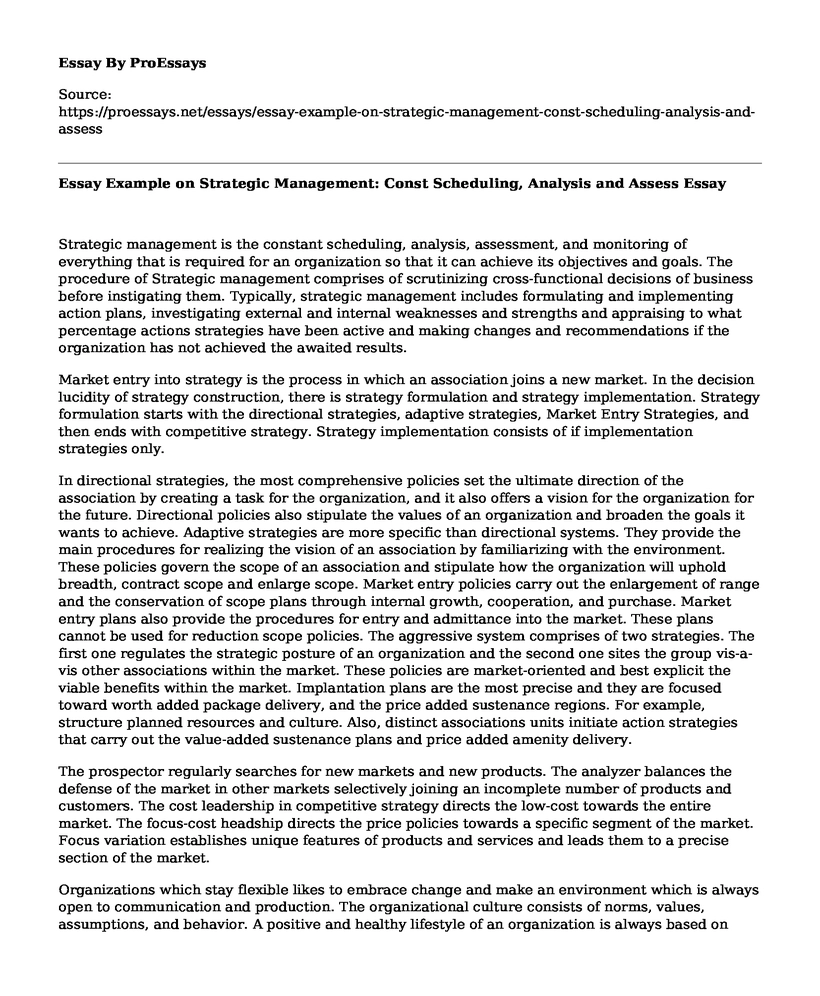Strategic management is the constant scheduling, analysis, assessment, and monitoring of everything that is required for an organization so that it can achieve its objectives and goals. The procedure of Strategic management comprises of scrutinizing cross-functional decisions of business before instigating them. Typically, strategic management includes formulating and implementing action plans, investigating external and internal weaknesses and strengths and appraising to what percentage actions strategies have been active and making changes and recommendations if the organization has not achieved the awaited results.
Market entry into strategy is the process in which an association joins a new market. In the decision lucidity of strategy construction, there is strategy formulation and strategy implementation. Strategy formulation starts with the directional strategies, adaptive strategies, Market Entry Strategies, and then ends with competitive strategy. Strategy implementation consists of if implementation strategies only.
In directional strategies, the most comprehensive policies set the ultimate direction of the association by creating a task for the organization, and it also offers a vision for the organization for the future. Directional policies also stipulate the values of an organization and broaden the goals it wants to achieve. Adaptive strategies are more specific than directional systems. They provide the main procedures for realizing the vision of an association by familiarizing with the environment. These policies govern the scope of an association and stipulate how the organization will uphold breadth, contract scope and enlarge scope. Market entry policies carry out the enlargement of range and the conservation of scope plans through internal growth, cooperation, and purchase. Market entry plans also provide the procedures for entry and admittance into the market. These plans cannot be used for reduction scope policies. The aggressive system comprises of two strategies. The first one regulates the strategic posture of an organization and the second one sites the group vis-a-vis other associations within the market. These policies are market-oriented and best explicit the viable benefits within the market. Implantation plans are the most precise and they are focused toward worth added package delivery, and the price added sustenance regions. For example, structure planned resources and culture. Also, distinct associations units initiate action strategies that carry out the value-added sustenance plans and price added amenity delivery.
The prospector regularly searches for new markets and new products. The analyzer balances the defense of the market in other markets selectively joining an incomplete number of products and customers. The cost leadership in competitive strategy directs the low-cost towards the entire market. The focus-cost headship directs the price policies towards a specific segment of the market. Focus variation establishes unique features of products and services and leads them to a precise section of the market.
Organizations which stay flexible likes to embrace change and make an environment which is always open to communication and production. The organizational culture consists of norms, values, assumptions, and behavior. A positive and healthy lifestyle of an organization is always based on spiritual connection and an environment which is caring with proper behavioral standards. They are assumed to be competitive benefits which are difficult to copy, sustainable, rare and valuable. The culture of an organization also aids in the implementation of strategies because a good culture replicates an upscale variation positioning plan. Hence, behaviors and culture will need to be relocated to the coalition partner.
Daily interaction with the workforce of the employees produces value by an emerging culture of wellness, empowering an effective deterrence and directing the workers to providers of high value. When policy implementation and learning, an association can operate in the universal market place more effectively. Culture permits the leaders of an organization to work both as groups and individuals so that they can create planned ingenuities within the organization.
Positive sum competition is whereby the health care competes to give the patients the best treatments, and they can identify the diseases more easily. The healthcare of the United States is in bad shape because the medical services are neither rationed or restricted, many patients are treated poorly, and there are rising rates of avoidable medical errors. According to Porter, he said that there has to be a change in how health care competes with one another because currently, it is operating at incorrect levels (Porter,2009). In a healthy organization, rivalry at the level of treatments and ailments becomes the engine of modification and development. Porter and Teisberg said that this type of Zero-sum competition must come to an end. If should be substituted by competition at the level of diagnosis, preventing and treating personal diseases and conditions (Porter, and Teisberg, 2004). The health care systems must introduce rules to stop price discrimination and coverage that are based on the risks of health and the current health problems.
I do not agree with the statement of the product life cycle because the approach of zero-sum has given competition and the guarantors of health a bad name. Health guarantors should compete in a way that will start value in the organization and make it more effective than the monopolies of the government.
References
Porter, M. E. (2009). A strategy for health care reform-toward a value-based system. New England Journal of Medicine, 361(2), 109-112.
Porter, M. E., & Teisberg, E. O. (2004). Redefining competition in health care. Harvard business review, 64-77.
Cite this page
Essay Example on Strategic Management: Const Scheduling, Analysis and Assess. (2023, Jan 02). Retrieved from https://proessays.net/essays/essay-example-on-strategic-management-const-scheduling-analysis-and-assess
If you are the original author of this essay and no longer wish to have it published on the ProEssays website, please click below to request its removal:
- Social Work Leadership and Strategic Planning Essay
- Essay Sample on Values and Strategies: Starbucks
- Essay on My Journey to Leadership: A Story of Success
- Leadership in Army: Impacting People & Achieving Goals - Essay Sample
- Leaders: Improve Communication Through Active Listening & Nonverbal Cues - Essay Sample
- Essay Example on Maximizing Cost Efficiency: The Benefits of Life-Cycle Cost Analysis (LCCA).
- Paper Sample on Benchmarking: Management Process for Continuous Improvement







